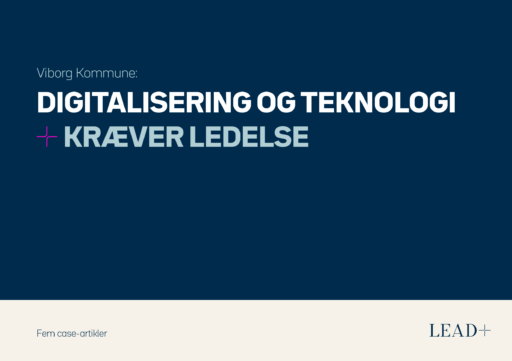Six competencies to succeed
Who doesn't feel that change is coming at us at a tremendous speed, forcing us to look at the world through new lenses and use ourselves in new ways in the workplace.
Disruption is the new order and for individuals and organizations, we risk being left behind if we fail to adapt in time. This requires agile organizations, competent employees and, not least, leaders who can manage the transition between the old analogue world and the new digital world. This article looks at the challenges for leaders in this digital transformation and provides six key suggestions for the competencies required of leaders in the future.
Changes in the wake of the digital transformation
Professor of IT management at CBS, Jan Damsgaard, writes in his 2015 book "The Digital Transformation" that we are in a digital revolution that is at least as pervasive as the industrial revolution. According to Damsgaard, this new complexity in society and the labor market means that more than one in three jobs will be taken over by computers and machines by 2035.
In addition, digital platforms are making it easier for companies to use freelancers and subcontractors rather than permanent employees, and more and more jobs are at risk of being outsourced to cheaper countries. Thus, there are many signs that the Danish labor market is heading into a storm that will change the current norms of how to make money, what a "job" is and how to be a leader.
We are already in the change
The changes are already visible: Google and Facebook have smashed the traditional advertising market in the media industry and taken over the media image of young people. Doctors have lost authority as patients have become specialists in their own diseases by reading about them online.
In hospitals, Watson the robot makes diagnoses based on nurses' smartphone images of patients. At car rental company Sixt, there are no middle managers over the age of 40 because young managers have their fingers on the smartphone and understand the impending revolutions in the transportation market better than their more experienced colleagues.
Mindset and culture must change
The impact of industrialization being replaced by digitalization is not just a matter of changing workflows, buying new software or having a social media presence. It's the mindset, culture and, most importantly, the way leadership is managed that needs to change, which in practice proves difficult for many.
Six essential skills for the digital leader
Based on my practical work with the digital transformation over the past seven years, as well as inspiration from authors Jan Damsgaard (2015) and Søren Schultz Hansen (2012), below are six essential competencies that the modern (digital) leader must master in the transition between the analog and digitalized world.
JOIN OUR COURSE
Build wellbeing and trust despite the distance
The "Managing Virtual and Hybrid Work Communities" course gives you the essential tools to increase productivity and well-being through remote management.
This is a course for those who work in management and want to know how to achieve strategic goals as an individual or organization through virtual collaboration.
1. Thinking like an architect
In urban planning, architects always integrate new buildings into the existing cityscape to create a connection between the old and new buildings. Similarly, the modern digital transformation leader must think about the new digital world alongside the "old" analog world and lead the transition between the two approaches.
It requires leaders to operate in the gap between the ever-necessary optimizations of existing processes on the one hand and innovative solutions supported by exponential digital technologies on the other. It's an adjustment between the old and new mindset in an organizational mix of hierarchical structure, free birds, anarchy and network organization, where employees go their own way based on what makes sense and where their skills lie.
Like the architect, the leader of the future must be able to create seamless transitions to maintain cohesion between subcultures, business models, professions, nationalities, generations, departments and technologies. Unfortunately, many organizations still see struggles between employees representing different worlds and perceptions.
Without a common direction and approach, the organization risks breaking down in the middle of the process. Silos need to be broken down and there needs to be the right balance between specialists and generalists, freelancers and permanent employees, as well as between the generations of digital natives and older (analog) colleagues in the organization.
It is the manager's responsibility to ensure that everyone understands and accepts initiatives that are a plus for the organization as a whole, even if they are not necessarily a plus for you or the department you belong to. For example, newspapers in the media industry often find that they have strategic goals that in some ways counteract or even cannibalize each other - for example, the analogue print newspaper versus the digital online newspaper. The trick is to be able to handle the double-edged focus and ensure that the organization can win on both swings and roundabouts, even though this in itself may seem like a management paradox.
2. Tackle change constructively and agile
Leading an agile organization that can quickly adapt and take on new positions increases the need for transparency, openness and ongoing dialogues about the need for change so that everyone in the organization is on board with what it takes to operate in a new terrain.
The leader must structure the organization and create innovative forums where tasks and decisions are delegated to the right people, so that the leader above all avoids becoming a roadblock to initiatives.
A role model here could be start-up companies. They are born agile and have a dynamic entrepreneurial spirit where employees take ownership of what the company produces. They have a strong ability to execute and avoid the traditional command-and-control structure. Start-ups work from a flat and simpler structure where employees are given free rein to make decisions without having to go through intermediaries that don't add anything new.
Another example is Google, which, recognizing that employees have a wealth of knowledge that they would like to unlock, gives them one day a week off from core operations to free up time for innovation.
While most people buy into the idea that development is important, few people clap their hands once they experience change first-hand. In the wake of change, there is often a lot of turmoil and resistance from employees who become insecure and frustrated because they feel their position is threatened. An essential competency for leaders is therefore to be able to manage this turmoil in the organization.
3. Use data intelligently
The access and use of data is becoming vital. Analyzing, predicting and making decisions based on (big) data creates evidence-based management - fact-based management that will play a key role in the future. But these are virgin paths we are treading here, because how
do we ensure that we are collecting and processing the right data? And how do we make sure we don't drown in all the data or manage according to the data that is available without thinking about the consequences for the culture? Do we manage and count according to what really counts? The answer is no.
In many places, data collection has been found to be inadequate or downright misleading, leading to incorrect decisions. Data processing is only as good as the people who use and interpret it. It is therefore an important task for managers to hire employees with the right skills for the job. But here, too, it's easy to get lost, because what are you looking for and can you even get the right digital/data skills when it comes down to it? Already today, there is a shortage of specific IT and data skills.
4. Works in sprints
The digital world, as it has evolved over the last 20 years, is characterized by large and rapid changes that make it less rational to manage according to a precisely defined and fixed goal. Five-year plans and goals attached to strategies belong to another time, just as silos, heavy decision-making processes, annual performance reviews and knowledge monopolies are the logic of industrial society.
The risk of steering in the wrong direction and ending up in the wrong place is high, and the conditions often turn out to be different when you reach your goal than when you set it. In the digital world, you're constantly gaining new knowledge during the process, which means you have to change your approach from what you thought made sense.
The right way to navigate is therefore not classic methodological freedom with clear objectives, but rather to work from a strategic intention with an emphasis on initial management and a more overarching, imprecise goal wrapped in an agile approach with room for deviation when the situation demands it. You work in "sprints" rather than trying to plan the entire process from start to finish, as more traditional methods dictate.
This method, called agile project management, was originally used for IT projects, but has now grown into other parts of the organization, where it is used to continuously prioritize projects so that they are focused on what creates the most value for the customer and the business.
5. Ability to lead the "Digital Natives"
A new generation of workers has entered the labor market - the "digital natives" (Hansen, 2012). Digital natives have a markedly different approach to working life, which means that old-school or traditional management styles need to be modified if you want to retain these talented young workers and integrate them with older employees in the workplace.
A characteristic of digital natives is that they no longer see their employment as a 'life project', but rather as a step in their career path that should allow for development and self-actualization. Some may see this as a shift in the concept of loyalty to their employer, but for the new generation of workers, the most important criteria for a workplace is that the job is autonomous, (career) developing and challenging.
Digital natives are good at relationships, they live in the moment and are trained to work their way up to the next level in virtual games, advancing/progressing according to their skills and achievements. To those of us who grew up with a different mindset, they can seem self-centered because they are so focused on their own development and self-actualization, and there's an anarchic quality to them that can be difficult to fit into a team culture.
For example, answering emails (which they find old-fashioned) or maintaining their focus on non-active tasks that easily slip into the background or are forgotten - just like yesterday's exciting Instagram photo is forgotten the next day. Young people are not as interested in delivering zero-defect solutions as previous generations, they are happy to share unfinished materials.
It can be perceived as sloppy, but it's more likely that young people are looking for meaning in everything they do. And for them, it doesn't make sense to worry about correct point size and consistent use of paragraph divisions, fonts and abbreviations until the idea is in place.
This opinion formation is at play in several places and challenges the traditional management approach. For example, in relation to traditional appraisal concepts. For digital natives, planning the development of an employee in an annual perspective is a symbol of stagnation and a lack of focus on development and visibility in management.
Young people want ongoing recognition and feedback, as they know it from social media, and that's not necessarily linked to the annual performance review with a form to fill out based on long-term plans. It's simply not dynamic enough.
6. Can manage self-management
The digital platforms create a networked society with a focus on fluid matrix organization, free birds, openness and agility in decision-making and adaptation. Søren Schultz Hansen writes in his book (Digitally native at work, 2012): "Mobile media makes us independent of space as a framework, but has in turn made us equally committed to time and accessibility.
"Good digital leadership is therefore not necessarily present leadership, but rather present leadership, which increasingly unfolds in time, not space. Where it's about cultivating the present, not necessarily presence".
Where the old management philosophy was roughly about finding the balance between clear organizational responsibility, incentives and coercion, the management and employees of the future must also be able to act in the network society. This must be built on top of and into existing organizational structures and practices and requires qualities such as: dialogue, presence, alliances, co-development, closer to citizens/customers and new forms of co-creation.
Because it involves managing some relatively autonomous employees and/or networks, it is referred to as a form of 'metagovernance', which is defined as 'managing self-management'. This is a balance between the exercise of hands-on and hands-off, which allows managers to let go without losing control.
The challenge is to avoid both under- and over-governance. Too much management undermines self-management, and too little management will cause the management network to collapse due to a lack of motivation, direction, coordination and conflict management.
There are a number of fundamental differences between the classic leaders that industrial society has fostered and the leaders that the digital age is fostering and demanding now. Technology is important, but leadership is arguably the most important ingredient in a digital transformation. When all business models go digital, the digital leader disappears and becomes simply a leader - the leader of the future.




